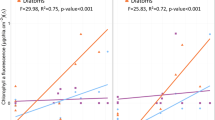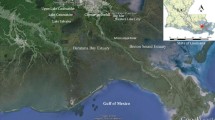Abstract
One of the most impacted watersheds in the US in terms of pesticide usage is South Florida, which drains through a series of canals into the Florida Everglades and Florida Bay. Single species responses to pesticide exposure are well documented; however, little is known about community level responses to pesticides, especially at lower trophic levels. Microbial assemblages at two sites along the C-111 canal in the Dade County agricultural area in October 1999 (wet season, limited pesticide application) and in February 2000 (dry season, heavy pesticide application) were colonized onto artificial substrates, transported to the laboratory and exposed to atrazine (20 and 200 μg/l), chlorothalonil (2 and 20 μg/l), or endosulfan (1 and 10 μg/l). Structural and functional responses were measured at 24h and 168h post-dose. Regardless of site, season or exposure time, the highest atrazine dose (200 μg/l) significantly reduced chlorophyll a, phototrophic carbon assimilation and bacterial biomass, but stimulated heterotrophic bacterial productivity. Chlorophyll a was also significantly reduced by 20 μg/l atrazine (October only). The lowest endosulfan dose (1 μg/l) significantly increased phototrophic carbon assimilation. The highest chlorothalonil dose (20 μg/l) stimulated heterotrophic bacterial productivity (October only). An overall decrease in the number of protist taxa was observed with all pesticide treatments. Atrazine significantly decreased the relative abundance of chlorophytes and chrysophytes and increased the number of diatom and heterotrophic protist taxa. Chlorothalonil significantly increased the relative abundance of diatoms and chlorophytes, while chrysophytes and heterotrophic protists decreased. Endosulfan also significantly reduced diatom abundance, as well as decreasing the number of chrysophyte, cryptophyte and dinoflagellate taxa. Although previous agricultural pesticide exposure was greater at site C than at site E, the microbial assemblages at site C did not exhibit increased resistance to a subsequent dose of the pesticides.
Similar content being viewed by others
Author information
Authors and Affiliations
Corresponding author
Rights and permissions
About this article
Cite this article
Downing, H.F., Delorenzo, M.E., Fulton, M.H. et al. Effects of the Agricultural Pesticides Atrazine, Chlorothalonil, and Endosulfan on South Florida Microbial Assemblages. Ecotoxicology 13, 245–260 (2004). https://doi.org/10.1023/B:ECTX.0000023569.46544.9f
Issue Date:
DOI: https://doi.org/10.1023/B:ECTX.0000023569.46544.9f




